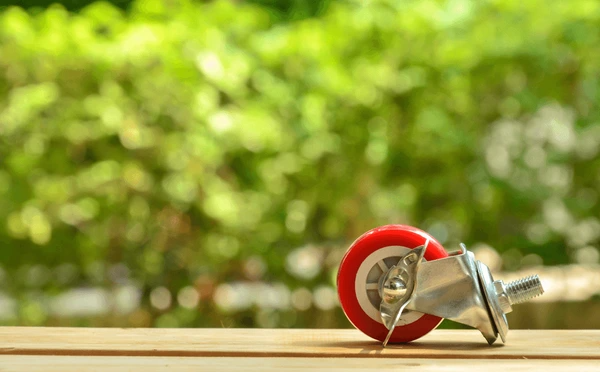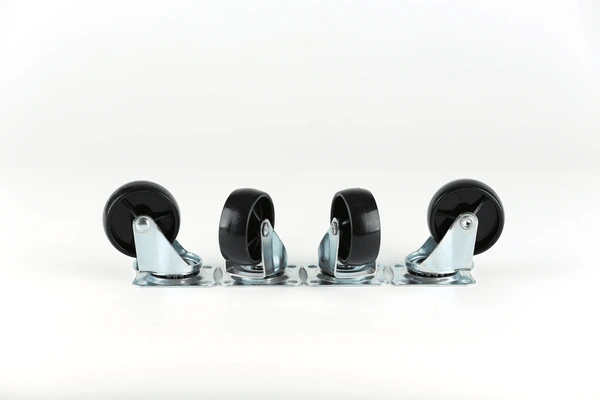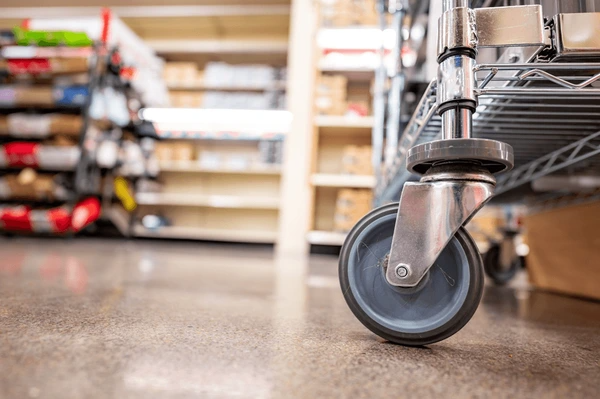
What is A Caster Wheel?
Caster wheels are a type of wheel assembly designed for mobility and manoeuvrability. They consist of a wheel mounted on a fork or yoke that can swivel about a vertical axis, allowing the wheel to pivot and change direction.

Types of Caster Wheels
- Wheel Skirt Casters: These have a skirt that fits over one side of the wheel to prevent interference with the locking mechanism. They are useful for applications where debris or objects on the floor could snag the wheel.
- Swivel Casters: These allow the wheel to pivot about a vertical axis, enabling multi-directional movement. They are commonly used in lawn and garden equipment, zero-turn mowers, and other applications requiring manoeuvrability.
- Driven Casters: These incorporate a drive assembly, drive shaft, and bevel gear to power the rotation of the wheel. This allows the caster to be driven in a horizontal direction, useful for mobile platforms and robotic applications.
- Expandable/Propeller Wheels: These can change the diameter or convert rotational movement into thrust, beneficial for off-road conditions and transportation in rough terrain.
Benefits of Caster Wheels

Mobility and Maneuverability
Caster wheels provide excellent mobility and maneuverability for objects they are attached to. Their ability to swivel 360 degrees allows for easy movement in any direction, making it convenient to navigate tight spaces and change directions. This enhanced maneuverability is particularly beneficial for applications like hospital equipment, office furniture, and shopping carts that require frequent repositioning.
Load Distribution and Stability
The unique design of caster wheels distributes the load evenly across multiple contact points, providing stability and preventing tipping. The self-aligning nature of caster wheels enhances stability, as they automatically adjust to uneven surfaces, ensuring a smooth and stable ride. The low center of gravity also contributes to the overall stability, making caster wheels ideal for heavy or top-heavy objects.
Reduced Noise and Vibration
Engineers design caster wheels to reduce noise and vibration, which is crucial in hospitals where quietness ensures patient comfort. The use of precision bearings, shock-absorbing materials, and innovative designs like dual-tread tires significantly reduces friction, vibration, and noise levels compared to traditional wheels.
Floor Protection
Manufacturers equip caster wheels with soft, non-marking tread materials to prevent scratches and floor damage. This feature is particularly important in environments with sensitive flooring, such as hardwood or tile, where traditional wheels could cause unsightly marks or scratches.
Versatility and Customization
Caster wheels are available in a wide range of sizes, materials, and load capacities, allowing for customization to suit specific application requirements. This versatility enables their use in diverse industries, from healthcare and office environments to manufacturing and material handling.
Applications of Caster Wheels

Material Handling and Logistics
Healthcare and Medical Equipment
In hospitals and healthcare facilities, caster wheels are indispensable for mobile equipment like hospital beds, stretchers, wheelchairs, and diagnostic machines. They allow easy movement and positioning of these devices, enhancing patient comfort and caregiver productivity.
Furniture and Office Equipment
Office chairs, desks, cabinets, and other furniture widely use caster wheels for effortless mobility and easy reconfiguration of workspaces. They facilitate ergonomic adjustments and contribute to a flexible and adaptable office environment.
Retail and Hospitality
Retail stores, hotels, and restaurants use caster wheels in shopping carts, luggage trolleys, and service carts to ensure smooth movement and transport of goods and supplies. They enhance customer experience and operational efficiency.
Industrial and Manufacturing
Caster wheels are crucial in industrial settings for moving heavy machinery, equipment, and tooling. They enable easy repositioning and reconfiguration of production lines, improving flexibility and reducing downtime. Specialized caster wheels with high load-bearing capacity are used in this sector.
Aerospace and Defense
In the aerospace and defense industries, caster wheels are used in ground support equipment, aircraft towing vehicles, and mobile radar systems. Their mobility and maneuverability are essential for efficient operations and rapid deployment in various terrains.
Construction and Agricultural Equipment
Construction equipment like concrete mixers, generators, and compressors use caster wheels, as do agricultural machines like tractors and harvesters. They facilitate easy movement and positioning of these heavy-duty vehicles and equipment in challenging environments.
Robotics and Automation
In robotics and automation systems, caster wheels are used for mobile platforms, automated guided vehicles (AGVs), and robotic arms. They enable smooth and precise movement, contributing to the overall efficiency and accuracy of these systems
Application Cases
| Product/Project | Technical Outcomes | Application Scenarios |
|---|---|---|
| Colson Casters | Utilising advanced polymer materials and precision engineering, Colson’s casters offer superior load-bearing capacity, durability, and manoeuvrability, reducing maintenance costs and downtime. | Material handling equipment, industrial machinery, and heavy-duty applications requiring robust and long-lasting caster solutions. |
| Blickle Wheel | Blickle’s innovative wheel designs incorporate specialised tread compounds and tyre profiles, enhancing traction, floor protection, and quiet operation, resulting in improved safety and ergonomics. | Healthcare facilities, clean rooms, and environments with stringent hygiene and noise reduction requirements. |
| Shepherd Caster | Shepherd’s casters feature advanced swivel designs and precision ball bearings, enabling superior manoeuvrability, responsiveness, and smooth rolling, enhancing user experience and productivity. | Office furniture, retail displays, and applications demanding effortless mobility and reconfiguration. |
| Albion Casters | Albion’s casters leverage advanced materials and coatings, offering superior corrosion resistance, chemical compatibility, and temperature tolerance, ensuring reliable performance in harsh environments. | Food processing, chemical plants, and extreme temperature applications, where durability and resistance to harsh conditions are critical. |
| RWM Casters | RWM’s casters incorporate innovative braking systems, directional locks, and anti-static designs, ensuring precise control, safety, and electrostatic discharge protection in sensitive environments. | Electronics manufacturing, cleanrooms, and static-sensitive applications, where precise control and ESD protection are paramount. |
Latest Technical Innovations of Caster Wheels
Wheel Skirt Designs
Caster wheels with a skirt or shield that partially encloses the wheel are gaining popularity, especially for office chairs and furniture. The skirt protects users’ feet from getting caught in the wheel while allowing free rotation. Key features include:
- A perimeter wall extending around the wheel with a resiliently deformable portion
- Connection arms to attach the shield to the caster wheel assembly
- The skirt covers one side of the wheel to avoid interference with locking mechanisms
Driven Caster Wheels
Driven or powered caster wheels incorporate a drive assembly to control wheel rotation for propelling the wheeled object. Innovations include:
- Separating the drive wheel and load-bearing wheel to prevent deformation
- Using a bevel gear to connect the drive shaft to the axle for horizontal driving
- Positioning the drive motor outside the wheel circumference for protection
Caster Braking Systems
Advanced braking mechanisms allow selective locking of caster wheels for stability:
- Simultaneous brake actuation from either end of a cart using linked handles
- Wedge components that engage the tread to prevent rolling in one direction
- Adjustable feet that extend from the caster base for leveling and increased stability
Magnetic Alignment
Magnets integrated into the caster assembly help maintain wheel alignment in the rolling direction for improved mobility:
- Opposing polarity magnets in the wheel mount and bearing plate create an aligning torque
- This magnetic force keeps the wheel pointed forward without resistance
Technical Challenges of Caster Wheels
| Caster Wheel Skirt Design | Developing a skirt or shield that partially encloses the caster wheel to protect users’ feet from getting caught while allowing free rotation. |
| Driven Caster Wheel Integration | Integrating a drive assembly to control caster wheel rotation for propelling the wheeled object, with innovations in separating the drive and load-bearing components. |
| Caster Wheel Braking Mechanisms | Developing advanced braking mechanisms to selectively lock caster wheels for stability, with simultaneous brake actuation and independent handle operation. |
| Caster Wheel Shock Absorption | Incorporating compressible tires or suspension systems to mitigate shocks and enable smooth movement over uneven surfaces. |
| Caster Wheel Steering Optimisation | Optimising caster wheel geometry and steering mechanisms to improve manoeuvrability, stability, and minimise scrubbing or shimmy. |
Discover More About Practical Tools and Materials
Shock Cords: Versatile Strength for Every Need
Understanding Power Steering Fluid: A Comprehensive Overview
Understanding Knurling: A Guide to Types, Tools, and Applications
To get detailed scientific explanations of the caster wheels, try Patsnap Eureka.

